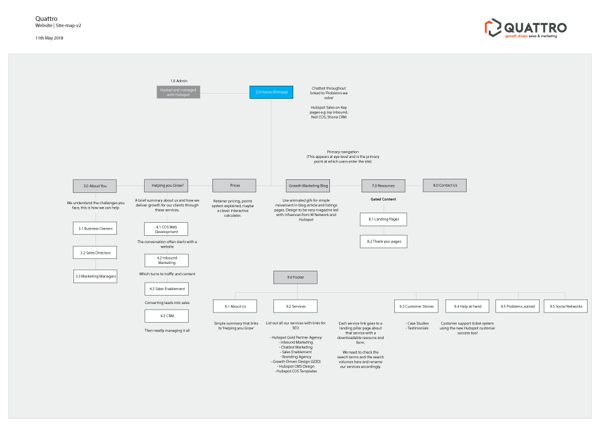So you’ve been given the enviable task of commissioning your companies new website, but where do you start?
Where do you start? It's all too easy to start off in the wrong direction
when planning your businesses new website.
The sales team, your marketing colleagues and the board of directors all agree that the old website is not doing the job and a new 'much better one' is required and as soon as possible.
But where do you start? Do you write a tender document, call your previous developer or start sketching some layouts yourself? In the next three blogs I’ll detail a series of web design tips and steps you should take to get you to that successful new website.
I’ll detail the actions you should take at the outset to make sure that you get the project off on the right foot, how you should source a project team to help you deliver it and what measurements you should put in place to prove how effective the new website is.
In this blog I'll look at the first and possibly the hardest part of any project, that’s getting started.
Where do you start?
The best place to start is with your audience. After all they are the ones you’re building the site for, so knowing what content they search for, how they search for it and where they go to search will help you with your planning. By answering these questions you will deal with two key areas that are fundamental to the success of any website;
-
Being found by potential customers
-
Providing the right content for those website visitors so they’ll keep coming back and ultimately convert into customers.
3 website design tips to help you plan a new site
1. Know your audience
It sounds strange but many website projects start with a visual, structure or a theme, but the problem with this approach is how can you tell if this is right if you don’t know what your audience want to gain that all important marketing qualified lead. I’ve seen businesses spend thousands of pounds on websites only to discover at the end of the process that they’d got it wrong and missed the mark with their audience. They’ve then had to go through the costly process of unpicking the website and redoing sections.
At Quattro, audience research is where all our work begins, it’s the reference point that we check everything against and it’s what underpins all our work.
So your first job is to get to know your audience. Start compiling a list of the types of clients you work for; we call these 'personas'. Start with the typical product or service they purchase from you, how much they spend and how often. Then add to this information, their typical age, gender, lifestyle and background. Think about how they found you in the first place (if you’re not sure ask them) was it a search engine, an advert, word of mouth or from a magazine. Then start to think about the typical problems or obstacles that stand in between them and making a purchase. Your sales team will be able to give you some valuable insights here. The more information you can compile now, the more informed your decisions will be, so consider this time well spent even if it feels like an arduous task.
The information you gather in this step will help you plot your customers journey through the website. It will help you identify common purchasing problems faced by your potential customers and most importantly will give you valuable intelligence about how they found you in the first place.
2. Research your keywords
Now that you know your audience a little better you need to discover what keywords they use to find businesses like yours. This may not seem like a web development task, but I can’t stress enough how important it is to do your keyword research at the beginning of a website development project. Keywords will help you shape your content to your audience but are also the key to being found online.
So how do you research your keywords?
The most effective method I’ve found is to first draw up a list of words or phrases that sum up your products or services, if it helps, group them by product or service. Then add the common problems/queries that stand between the buyer and their purchase that you discovered in the first step.
You should now have a good potential list of keywords. The next step is to discover whether the phrases and terms you’ve selected are commonly searched or whether there are other more relevant ones.
The best tool for this is Google’s keyword planner. Add your keywords and phrases to the planner and it will show you how many people have searched for your chosen term or phrase, how much competition there is for that phrase but also alternatives for you to consider. Look for terms with a large number of searches, low competition and ones that are relevant to your business. Quite often you’ll find that the keywords you want have a huge amount of competition. If this is the case make your phrase broader by adding your location to it, or a description like a colour, size or value statement.
3. Start shaping your content
Now that you’ve established who your audiences are, and their needs, your job is to meet those needs with content. The best way to do this is by creating a sitemap, which is a skeletal plan of your site.
Draw a tree diagram like the one illustrated. Create a list of sections, the pages that fall within those sections and how each page links to the next. Use your existing website as a place to start, it doesn’t matter if it’s wrong at this stage the key task here is creating a plan which contains all the content you need to feature on the new website.

Creating a sitemap helps you plan your content and visualise your website's structure
Once you’ve done this, look back at your audience research and compare their needs and requirements with the content in your sitemap. Look for any gaps in your content. If there are gaps, create a new page that fills the gap. The next step is to assign the keywords you established in step 2 to pages on your website. The purpose of assigning keywords to content is to help potential customers find your content. Each page must have a theme and have 2 or 3 keywords assigned to it. Go through your keyword research and assign appropriate keywords to each page of your site.
Now that you have a plan that contains the structure and content for your site, you need to establish whether that structure is right for your audience. You know that the content is right from the steps above, the next step is to order it in a logical way that’s most suited to your audience.
Next Steps
In the next blog (due out later this week) we’ll look at how you plan your visitors journey and how to formulate the right team to deliver your new website.
Website Design Tips
TOP TIP
You don’t need to wait for a new website to prepare content, do it now and craft it well. Good content takes time, so start early in the process as additional requirements like illustrations, photography and charts that help illustrate a point will crop up and you’ll need time to get them designed.
Don't forget to read the next blog 'Creating the ultimate website project team'
Related Posts
Subscribe to updates
Fill in your details below to recieve regular Quattro updates direct to your inbox.

